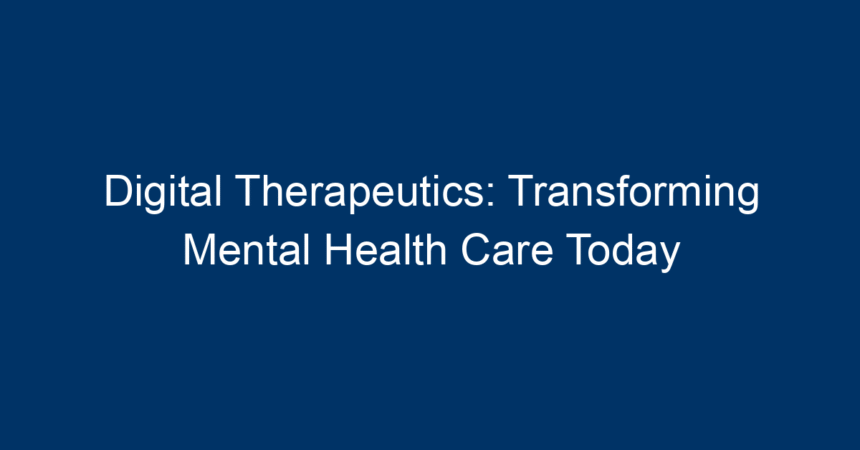In recent years, mental health care has undergone a monumental shift. As awareness around mental health issues grows, so does the need for innovative and effective treatment options. Enter digital therapeutics—an emerging field harnessing the power of technology to deliver evidence-based therapeutic interventions. This article dives into how digital therapeutics are revolutionizing mental health care, paving the way for more effective, accessible, and personalized treatments.
Understanding Digital Therapeutics
What Are Digital Therapeutics?
Digital therapeutics are software-driven interventions designed to prevent, manage, or treat medical disorders or diseases. Distinct from general wellness apps, they are based on clinical evidence and are often prescribed by healthcare professionals. These tools utilize algorithms and therapeutic methodologies to provide tailored care, primarily aimed at conditions such as depression, anxiety, and other mental health disorders.
The Science Behind Digital Therapeutics
Digital therapeutics are grounded in extensive research and clinical trials. They integrate behavioral health principles with advanced technology, employing mechanisms like cognitive-behavioral therapy (CBT), mindfulness strategies, or motivational interviewing. The primary goal is to deliver real-time data and support, ensuring patients receive the necessary care without the barriers of traditional settings.
The Role of Digital Therapeutics in Mental Health Care
Increased Accessibility
One of the significant advantages of digital therapeutics is their ability to make mental health care more accessible. Traditional therapy can have geographic, financial, and temporal barriers. Digital solutions are available on-demand, allowing users to engage with their therapeutic programs whenever and wherever they need them.
Moreover, they can serve as a bridge for individuals residing in rural or underserved areas, where mental health professionals might be scarce. This increased accessibility ensures that more people receive the support they need, which is critical in managing mental health conditions effectively.
Personalized Treatment
Another standout feature of digital therapeutics is their capacity for personalized care. Utilizing data from user interactions, these platforms can adapt in real-time to meet individual needs. For instance, some digital therapeutics use artificial intelligence (AI) to analyze user behavior, customizing content and recommendations based on user feedback and progress.
This level of personalization enhances engagement and efficacy, as individuals are more likely to stick with a program that resonates with their unique experiences and challenges.
Improved Monitoring and Data Collection
Digital therapeutics provide healthcare providers with valuable insights into their patients’ behaviors and progress. With the integration of wearables and mobile apps, practitioners can track metrics like mood, activity levels, and sleep patterns. Such data allows for better management of treatment plans and fosters a more collaborative relationship between patients and clinicians.
Enhanced Engagement and Retention
Many digital therapeutic platforms incorporate gamification techniques and interactive content to boost user engagement. Elements such as rewards, challenges, and progress tracking encourage users to remain committed to their treatment paths. For many, these interactive features help to demystify the therapeutic process, making treatment feel more like a personal journey rather than a chore.
Examples of Digital Therapeutics in Action
1. Woebot
Woebot is an AI-driven chatbot that provides emotional support and mental health resources. Utilizing CBT principles, Woebot engages with users to help them track their mood and address mental health challenges. Its interactive platform makes therapy accessible through casual conversations, allowing users to explore their feelings in a non-threatening environment.
2. Pear Therapeutics
Pear Therapeutics focuses on developing prescription digital therapeutics. Their product, reSET, provides a structured program for individuals with substance use disorders, integrating therapy and behavioral strategies. The platform encourages patients to engage actively with their recovery process, offering tools to address triggers and cravings.
3. Headspace
While primarily known as a meditation app, Headspace has evolved to deliver digitally-therapeutic interventions targeting anxiety, stress, and sleep disorders. Its curated content and specialized programs make it simpler for users to incorporate mindfulness into their daily lives, proving crucial in improving mental well-being.
Challenges Facing Digital Therapeutics
Despite their potential, several challenges must be addressed for digital therapeutics to reach their full promise.
Regulatory and Reimbursement Issues
The regulatory landscape for digital therapeutics is still developing. Many healthcare providers and payers remain uncertain about reimbursement for digital therapeutics, causing hesitance among practitioners to recommend these solutions.
Integration into Traditional Care Models
Integrating digital therapeutics into existing healthcare frameworks can be a complex task. Providers may need additional training on how to incorporate these tools into their practice, which could delay widespread adoption.
Privacy Concerns
With data privacy being a crucial concern for patients, digital therapeutics must prioritize securing sensitive information. Users need assurance that their data is handled responsibly and ethically, which is vital for building trust.
Future Prospects of Digital Therapeutics
As technology continues to advance, the potential of digital therapeutics in mental health care is vast. Here are some predictions for the next few years:
Increased Collaborations
We can expect more collaborations between tech companies and healthcare institutions. This partnership could lead to innovative digital solutions that provide cutting-edge care while maintaining clinical rigor.
Expansion of Evidence-Based Solutions
As more clinical studies validate various digital therapeutic approaches, the therapeutic landscape will further expand. Expect to see more comprehensive and effective solutions addressing a broader range of mental health conditions.
Greater Personalization through AI
Future digital therapeutics will likely rely heavily on AI and machine learning to create tailored experiences for users. These advancements will enable real-time adaptations in treatment plans based on user behavior and feedback.
Conclusion: Embracing the Change
Digital therapeutics are more than just apps; they represent a paradigm shift in mental health care. By increasing accessibility, providing personalized treatment, and leveraging data for better monitoring, these solutions hold the potential to transform lives.
As stakeholders in healthcare begin to embrace digital therapeutics, individuals experiencing mental health challenges can look forward to a future where treatment is more integrative, personalized, and engaging. The journey towards comprehensive mental health care is underway, and it’s essential for healthcare providers, policymakers, and individuals alike to advocate for the adoption and integration of these innovative solutions.
By tapping into the advantages of digital therapeutics, we collectively take a step closer to a world where mental health care is accessible to all, making mental well-being a primary focus in our society. Embrace this digital revolution; it’s time to prioritize mental health care today!




